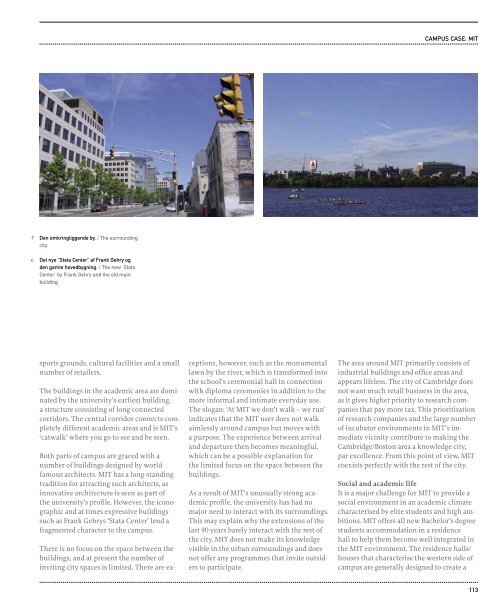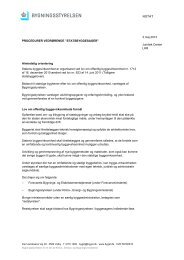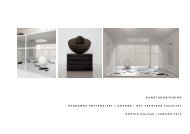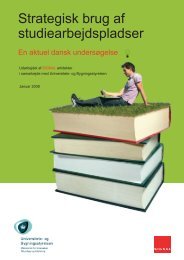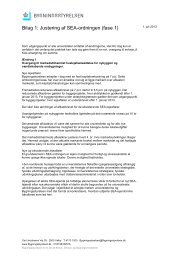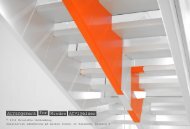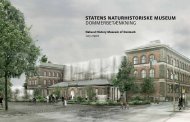Campus og studiemiljø - Bygningsstyrelsen
Campus og studiemiljø - Bygningsstyrelsen
Campus og studiemiljø - Bygningsstyrelsen
You also want an ePaper? Increase the reach of your titles
YUMPU automatically turns print PDFs into web optimized ePapers that Google loves.
i<br />
d<br />
den omkringliggende by. / the surrounding<br />
city.<br />
det nye ”stata Center” af Frank gehry <strong>og</strong><br />
den gamle hovedbygning. / the new ‘stata<br />
Center’ by Frank gehry and the old main<br />
building.<br />
sports grounds, cultural facilities and a small<br />
number of retailers.<br />
The buildings in the academic area are dominated<br />
by the university’s earliest building,<br />
a structure consisting of long connected<br />
corridors. The central corridor connects completely<br />
different academic areas and is MIT’s<br />
‘catwalk’ where you go to see and be seen.<br />
Both parts of campus are graced with a<br />
number of buildings designed by worldfamous<br />
architects. MIT has a long-standing<br />
tradition for attracting such architects, as<br />
innovative architecture is seen as part of<br />
the university’s profile. However, the icon<strong>og</strong>raphic<br />
and at times expressive buildings<br />
such as Frank Gehrys ‘Stata Center’ lend a<br />
fragmented character to the campus.<br />
There is no focus on the space between the<br />
buildings, and at present the number of<br />
inviting city spaces is limited. There are ex-<br />
ceptions, however, such as the monumental<br />
lawn by the river, which is transformed into<br />
the school’s ceremonial hall in connection<br />
with diploma ceremonies in addition to the<br />
more informal and intimate everyday use.<br />
The sl<strong>og</strong>an: ‘At MIT we don’t walk – we run’<br />
indicates that the MIT user does not walk<br />
aimlessly around campus but moves with<br />
a purpose. The experience between arrival<br />
and departure then becomes meaningful,<br />
which can be a possible explanation for<br />
the limited focus on the space between the<br />
buildings.<br />
As a result of MIT’s unusually strong academic<br />
profile, the university has had no<br />
major need to interact with its surroundings.<br />
This may explain why the extensions of the<br />
last 90 years barely interact with the rest of<br />
the city. MIT does not make its knowledge<br />
visible in the urban surroundings and does<br />
not offer any pr<strong>og</strong>rammes that invite outsiders<br />
to participate.<br />
<strong>Campus</strong> Case: mit<br />
The area around MIT primarily consists of<br />
industrial buildings and office areas and<br />
appears lifeless. The city of Cambridge does<br />
not want much retail business in the area,<br />
as it gives higher priority to research companies<br />
that pay more tax. This prioritisation<br />
of research companies and the large number<br />
of incubator environments in MIT’s immediate<br />
vicinity contribute to making the<br />
Cambridge/Boston area a knowledge city,<br />
par excellence. From this point of view, MIT<br />
coexists perfectly with the rest of the city.<br />
social and academic life<br />
It is a major challenge for MIT to provide a<br />
social environment in an academic climate<br />
characterised by elite students and high ambitions.<br />
MIT offers all new Bachelor’s degree<br />
students accommodation in a residence<br />
hall to help them become well integrated in<br />
the MIT environment. The residence halls/<br />
houses that characterise the western side of<br />
campus are generally designed to create a<br />
113


